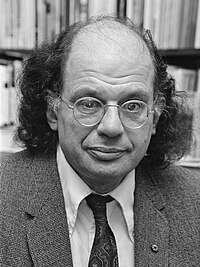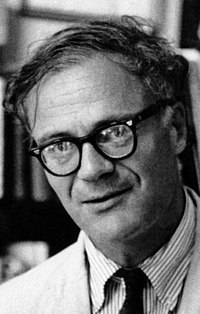(Added Millay.) |
(Added Bukowski.) |
||
| (10 intermediate revisions by the same user not shown) | |||
| Line 1: | Line 1: | ||
{{:Poetry/Tabs}} | {{:Poetry/Tabs}} | ||
{{dc|P}}{{start|oetry after World War II}} is often referred to as the "post-war" or "contemporary" period. | |||
{{Collapse top|title=General Characteristics|bg=#F0F2F5|left=yes}} | |||
{{ | Some general characteristics of contemporary poetry include: | ||
* Interest in the individual: Like modernist poetry, post-war English poetry places a strong emphasis on the individual, their experiences, and their emotions. | |||
* | * Rejection of traditional forms: Post-war poets often rejected traditional forms of poetry and experimented with new forms, including free verse, prose poetry, and visual poetry. | ||
* | * Political and social commentary: Post-war poetry frequently engages with political and social issues of the time, such as the Cold War, civil rights, and feminism. | ||
* Confessional poetry: Some post-war poets, such as Sylvia Plath and Robert Lowell, wrote confessional poetry that explores their own personal struggles, often with mental illness or family issues. | |||
* Use of irony and humor: Post-war poetry often employs irony and humor to critique the social and political status quo. | |||
* Interest in language and sound: Post-war poets often experiment with language, using sound, rhythm, and wordplay to create new effects and meanings. | |||
* Eclectic influences: Post-war poets draw from a wide range of literary and cultural influences, including modernism, surrealism, jazz, and popular culture. | |||
{{Big|Constantine Cavafy}} | These characteristics are not exhaustive, and there is considerable variety and diversity within post-war poetry. However, they provide a sense of some of the key features of the period. | ||
{{Collapse bottom}} | |||
{{FH}} | |||
<div style="display: flex; justify-content: center; padding: 25px 0 25px 0;"> | |||
{| style="width: 80%;" | |||
|- style="font-align: left;" | |||
| colspan="3" | {{Big|Maya Angelou}} | |||
|- style="vertical-align: top;" | |||
| colspan="3" |{{bulleted list|“[[February 23, 2023|Still I Rise]]”}} | |||
|- | |||
| colspan="3" | {{Line}} | |||
|- style="font-align: left;" | |||
| colspan="3" | {{Big|Margaret Atwood}} | |||
|- style="vertical-align: top;" | |||
| colspan="3" |{{bulleted list|“[[November 13, 2017|Circe, Mud Poems]]” (excerpt)}} | |||
|- | |||
| colspan="3" | {{Line}} | |||
|- style="font-align: left;" | |||
| colspan="3" | {{Big|Gwendolyn Brooks}} | |||
|- style="vertical-align: top;" | |||
| colspan="3" |{{bulleted list|“[[May 23, 2020|Primer For Blacks]]”|“[[May 30, 2020#Cool|We Real Cool]]”}} | |||
|- | |||
| colspan="3" | {{Line}} | |||
|- style="font-align: left;" | |||
| colspan="3" | {{Big|Charles Bukowski}} | |||
|- style="vertical-align: top;" | |||
| colspan="3" |{{bulleted list|“[[The Laughing Heart]]”}} | |||
|- | |||
| colspan="3" | {{Line}} | |||
|- style="font-align: left;" | |||
| colspan="3" | {{Big|Constantine Cavafy}} | |||
|- style="vertical-align: top;" | |||
| colspan="2" |{{bulleted list|“[[June 14, 2003|And I Lounged and Lay on Their Beds]]”|“[[July 23, 2003|Ithaka]]”}} | |||
| [[File:Konstantinos Kavafis.jpg|thumb|200px]] | |||
|- | |||
| colspan="3" | {{Line}} | |||
|- style="font-align: left;" | |||
| colspan="3" | {{Big|Lucille Clifton}} | |||
|- style="vertical-align: top;" | |||
| colspan="3" |{{bulleted list|“[[June 16, 2020#Hips|homage to my hips]]”|“[[June 16, 2020#Visions|seeker of visions]]”|“[[June 16, 2020|won’t you celebrate with me]]”}} | |||
|- | |||
| colspan="3" | {{Line}} | |||
|- style="font-align: left;" | |||
| colspan="3" | {{Big|Allen Ginsburg}} | |||
|- style="vertical-align: top;" | |||
| colspan="2" |{{bulleted list|“[[November 9, 2020#Ginsberg|New Democracy Wish List]]”}} | |||
| | |||
[[File:Allen Ginsberg 1979 - cropped.jpg|thumb|200px]] | |||
|- | |||
| colspan="3" | {{Line}} | |||
|- style="font-align: left;" | |||
| colspan="3" | {{Big|Audre Lord}} | |||
|- style="vertical-align: top;" | |||
| colspan="2" |{{bulleted list|“[[February 15, 2023|Who Said It Was Simple]]”}} | |||
| [[File:Audre Lorde.jpg|thumb|200px]] | |||
|- | |||
| colspan="3" | {{Line}} | |||
|- style="font-align: left;" | |||
| colspan="3" | {{Big|Philip Larkin}} | |||
|- style="vertical-align: top;" | |||
| colspan="3" |{{bulleted list|“[[May 15, 1996|The Mower]]”}} | |||
|- | |||
| colspan="3" | {{Line}} | |||
|- style="font-align: left;" | |||
| colspan="3" | {{Big|Robert Lowell}} | |||
|- style="vertical-align: top;" | |||
| colspan="2" |{{bulleted list|“[[November 15, 2020|Waking Early Sunday Morning]]”}} | |||
| [[File:Robert-lowell-by-elsa-dorfman (cropped).jpg|thumb|200px]] | |||
|- | |||
| colspan="3" | {{Line}} | |||
|- style="font-align: left;" | |||
| colspan="3" | {{Big|Edna St. Vincent Millay}} | |||
|- style="vertical-align: top;" | |||
| colspan="2" |{{bulleted list|“[[April 1, 2018|April]]”}} | |||
| [[File:Edna St. Vincent Millay Portrait (c. 1920).jpg|thumb|200px]] | |||
|- | |||
| colspan="3" | {{Line}} | |||
|- style="font-align: left;" | |||
| colspan="3" | {{Big|Adrienne Rich}} | |||
|- style="vertical-align: top;" | |||
| colspan="3" |{{bulleted list|“[[Diving Into the Wreck]]”}} | |||
|- | |||
| colspan="3" | {{Line}} | |||
|- style="font-align: left;" | |||
| colspan="3" | {{Big|Carl Sandberg}} | |||
|- style="vertical-align: top;" | |||
| colspan="3" |{{bulleted list|“[[June 29, 2003|Choose]]”}} | |||
|- | |||
| colspan="3" | {{Line}} | |||
|- style="font-align: left;" | |||
| colspan="3" | {{Big|Patricia Smith}} | |||
|- style="vertical-align: top;" | |||
| colspan="3" |{{bulleted list|“[[February 13, 2023|10-Year-Old Shot Three Times, but She’s Fine]]”}} | |||
|- | |||
| colspan="3" | {{Line}} | |||
|- style="font-align: left;" | |||
| colspan="3" | {{Big|Mark Strand}} | |||
|- style="vertical-align: top;" | |||
| colspan="3" |{{bulleted list|“[[June 20, 2003|Keeping Things Whole]]”|“[[June 20, 2003#Eating|Eating Poetry]]”}} | |||
|- | |||
| colspan="3" | {{Line}} | |||
|- style="font-align: left;" | |||
| colspan="3" | {{Big|Derek Walcott}} | |||
|- style="vertical-align: top;" | |||
| colspan="2" |{{bulleted list|“[[June 24, 2003|Journey]]”}} | |||
| [[File:Derek Walcott.jpg|thumb|200px]] | |||
|}</div> | |||
[[Category:Index]] | [[Category:Index]] | ||
[[Category:Poetry]] | [[Category:Poetry]] | ||
[[Category:Contemporary]] | [[Category:Contemporary]] | ||
Latest revision as of 10:34, 27 February 2024
Poetry after World War II is often referred to as the "post-war" or "contemporary" period.
General Characteristics
|
|---|
|
Some general characteristics of contemporary poetry include:
These characteristics are not exhaustive, and there is considerable variety and diversity within post-war poetry. However, they provide a sense of some of the key features of the period. |
| Maya Angelou | ||
| Margaret Atwood | ||
| ||
| Gwendolyn Brooks | ||
| Charles Bukowski | ||
| Constantine Cavafy | ||
| Lucille Clifton | ||
| Allen Ginsburg | ||
| Audre Lord | ||
| Philip Larkin | ||
| Robert Lowell | ||
| Edna St. Vincent Millay | ||
|
||
| Adrienne Rich | ||
| Carl Sandberg | ||
| ||
| Patricia Smith | ||
| Mark Strand | ||
| Derek Walcott | ||
|
||





